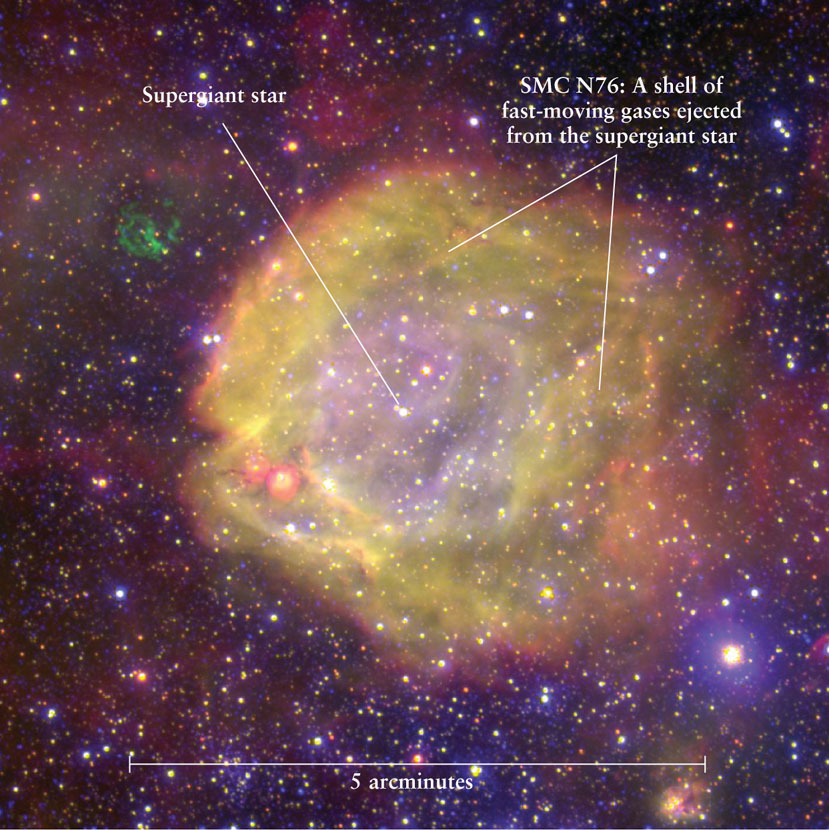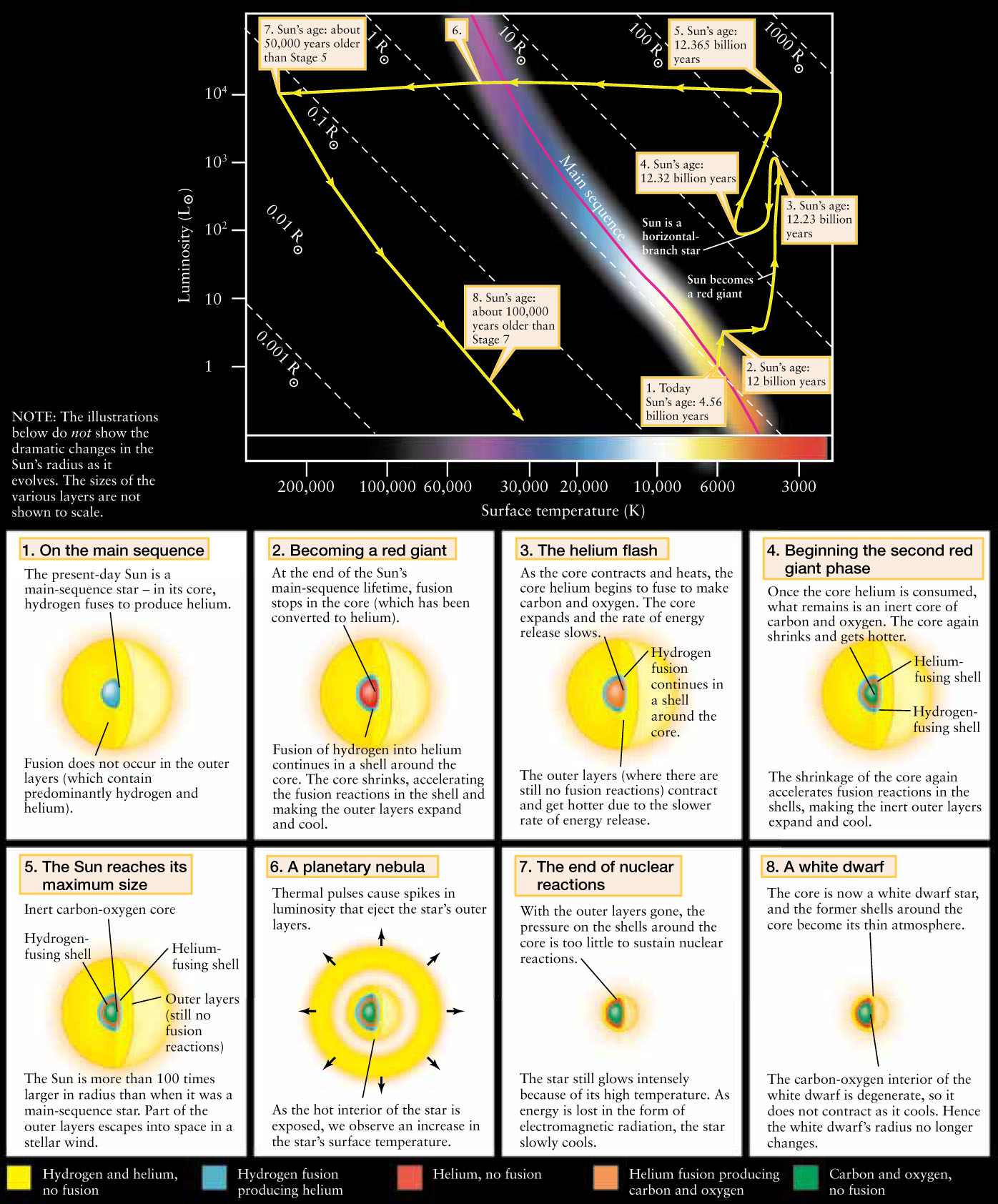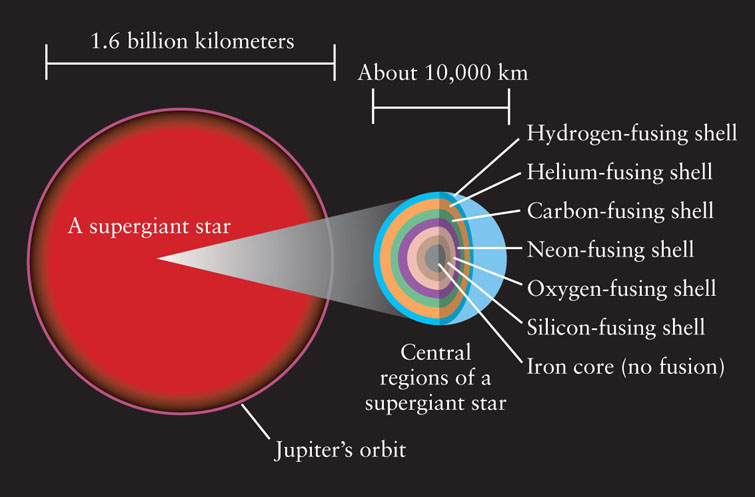20-5 High-mass stars create heavy elements in their cores
During the entire lifetime of a low-mass red dwarf star (with an initial mass less than about 0.4 M⊙), the only nuclear reaction that takes place is the fusion of hydrogen nuclei to form helium nuclei. In stars with initial masses from about 0.4 M⊙ to about 4 M⊙, a second kind of nuclear reaction takes place—helium fusion. The heaviest elements manufactured by helium fusion are carbon and oxygen.
The life story of a high-mass star (with a main-sequence mass greater than about 4 M⊙) begins with these same reactions. But calculations show that high-mass stars can also go through several additional stages of nuclear reactions involving the fusion of carbon, oxygen, and other heavy nuclei. As a result, high-mass stars end their lives quite differently from low-mass stars.
Heavy-Element Fusion in Massive Stars
Why is fusion of heavy nuclei possible only in a high-mass star? The reason is that heavy nuclei have large electric charges: For example, a nucleus of carbon has 6 positively charged protons and hence 6 times the charge of a hydrogen nucleus (which has a single proton). This means that there are strong repulsive electric forces that tend to keep these nuclei apart. Only at the great speeds associated with extremely high temperatures can the nuclei travel fast enough to overcome their mutual electric repulsion and fuse together. To produce these very high temperatures at a star’s center, the pressure must also be very high. Hence, the star must have a very large mass, because only such a star has strong enough gravity trying to pull it together and thus strong enough pressure at its center.
As we discussed in Section 19-2, when a main-sequence star with a mass greater than about 0.4 M⊙ uses up its core hydrogen, it begins shell hydrogen fusion and enters a red giant phase. Such a star then begins core helium fusion when the core temperature becomes high enough. The differences between moderately low-mass (from about 0.4 M⊙ to about 4 M⊙) and high-mass stars (more than about 4 M⊙) become pronounced after helium core fusion ends, when the core is composed primarily of carbon and oxygen.
Let us consider how the late stages in the evolution of a high-mass star differ from those of a low-mass star. In low-mass stars, as we saw in Section 20-4, fusion stops in the carbon-oxygen core; it eventually becomes a white dwarf. But in stars whose overall mass is more than about 4 M⊙, the temperature and pressure of the carbon-oxygen core is enough to trigger further fusion reactions. The first of the new nuclear reactions is carbon fusion, which consumes carbon nuclei and produces oxygen, neon, sodium, and magnesium.
If a star has an even larger main-sequence mass of about 8 M⊙ or so (before mass ejection), even more nuclear reactions can take place. After the cessation of carbon fusion, the core will again contract, and the star’s central temperature exceeds 1 billion kelvins (109 K). Around this temperature neon fusion begins. This uses up the neon accumulated from carbon fusion and further increases the amount of oxygen and magnesium in the star’s core.
After neon fusion ends, the core will again contract, and oxygen fusion begins. The principal product of oxygen fusion is silicon. Once oxygen fusion is over, the core will contract yet again. With this contraction, the central temperature rises and silicon fusion begins, producing a variety of nuclei from sulfur to iron and nickel. While all of this fusion is going on in the star’s interior, at the surface the star is losing mass at a rapid rate (Figure 20-12).

Mass Loss from a Supergiant Star At the heart of this nebulosity, called SMC N76, lies a supergiant star with a mass of at least 18 M⊙. This star is losing mass at a rapid rate in a strong stellar wind. As this wind collides with the surrounding interstellar gas and dust, it creates the “bubble” shown here. SMC N76, which has an angular diameter of 130 arcsec, lies within the Small Magellanic Cloud, a small galaxy that orbits our Milky Way. It is about 60,600 pc (198,000 ly) distant.
As a high-mass star consumes increasingly heavier nuclei, the nuclear reactions produce a wider variety of products. For example, oxygen fusion produces not only silicon but also magnesium, phosphorus, and sulfur. Some nuclear reactions that create heavy elements also release neutrons. A neutron is like a proton except that it carries no electric charge. Therefore, neutrons are not repelled by positively charged nuclei, and so can easily collide and combine with them. This absorption of neutrons by nuclei, called neutron capture, creates many elements and isotopes that are not produced directly in fusion reactions.
Each stage of nuclear reactions in a high-mass star helps to trigger the succeeding stage. In each stage, when the star exhausts a given type of nuclear fuel in its core, gravitational contraction takes the core to ever-higher densities and temperatures, thereby igniting the “ash” of the previous fusion stage—and possibly the outlying shell of unburned fuel as well.
COSMIC CONNECTIONS
Our Sun: The Next Eight Billion Years
The Sun is presently less than halfway through its lifetime as a main-sequence star. The H-R diagram and cross-sections on this page summarize the dramatic changes that will take place when the Sun’s main-sequence lifetime comes to an end.

Supergiant Stars and Their Evolution
The increasing density and temperature of the core make each successive nuclear reaction more rapid than the one that preceded it. As an example, Table 20-1 shows a theoretical calculation of the evolutionary stages for a star with an initial main-sequence mass of 25 M⊙. This calculation indicates that carbon fusion in such a star lasts for a 1000 years, neon fusion for 3 years, and oxygen fusion for only 3.6 months. The last, and briefest, stage of nuclear reactions is silicon fusion. The entire core supply of silicon in a 25-M⊙ star is used up in only 5 days!
| Stage | Core temperature (K) | Core density (kg/m3) | Duration of stage |
|---|---|---|---|
| Hydrogen fusion | 7 × 107 | 10 × 103 | 107 years |
| Helium fusion | 2 × 108 | 2 × 106 | 106 years |
| Carbon fusion | 8 × 108 | 109 | 1000 years |
| Neon fusion | 1.6 × 109 | 1010 | 3 years |
| Oxygen fusion | 1.8 × 109 | 1010 | 3.6 months |
| Silicon fusion | 2.5 × 109 | 1011 | 5 days |
| Core collapse | 1010 | 1013 | ¼ second |
| Explosive (supernova) | about 109 | varies | 10 seconds |
| Based on calculations by Stanford Woosley (University of California, Santa Cruz)and H.-T. Janka. | |||
A star of 8 or more solar masses evolves into a supergiant 100 times (or more) larger than the Sun
Each stage of core fusion in a high-mass star generates a new shell of material around the core. After several such stages, the internal structure of a truly massive star—say, 25 to 30 M⊙ or greater—resembles that of an onion (Figure 20-13). Notice the order of the layers in Figure 20-13—the earlier the fusion reaction begins, the farther it is from the center. Because nuclear reactions can take place simultaneously in several shells, energy is released at such a rapid rate that the star’s outer layers expand tremendously. The result is a supergiant star, whose luminosity and radius are much larger than those of a giant (see Section 17-7).

Several of the brightest stars in the sky are supergiants, including Betelgeuse and Rigel in the constellation Orion and Antares in the constellation Scorpius. (Figure 17-15 shows the locations of these stars on an H-R diagram.) They appear bright not because they are particularly close, but because they are extraordinarily luminous.
The End of Nuclear Fusion
A supergiant star cannot keep adding shells to its “onion” structure forever, because the sequence of nuclear fusion reactions cannot go on indefinitely. In order for atoms to serve as a nuclear fuel, energy must be given off when they collide and fuse.
Let’s consider a common case in which a helium nucleus fuses with a larger atomic nucleus, although the results apply beyond helium. When they are close enough (due to high temperatures and pressures), the helium atom and the larger atom are pulled together by strong nuclear forces and energy is released. However, to get close enough, the atoms must overcome a repulsive force because all protons repel each other. As a result, fusion with larger atomic nuclei becomes increasingly difficult as the larger atom’s greater number of protons leads to a greater repulsive electric force against the protons in the smaller helium nucleus. Very large atoms can be fused with helium, but they require an input of energy, rather than releasing energy. Everything in a star changes when a fusion reaction requires an input of energy in order to occur.
To act as a fuel, nuclear fusion reactions must release energy; this is the energy that powers a star. As larger and larger atoms are built up inside a star’s core, they will eventually approach a size where they can no longer release energy through fusion and would instead require an input of energy to fuse. At this point, the star has run out of nuclear fuel in its core: Iron is the first atom produced for which further fusion does not release energy. As silicon fusion produces iron, the iron atoms in the core steadily grow in number without fusing into even larger atoms. Hence, the sequence of energy-producing fusion stages ends with silicon fusion, and no new layers in the fusing “onion” shells of Figure 20-13 will be produced. Shell fusion in the layers surrounding the iron-rich core consumes the star’s remaining reserves of fuel. At this stage the entire energy-producing region of the star is contained in a volume no bigger than Earth, some 106 times smaller in radius than the overall size of the star. This state of affairs will soon come to an end, because the buildup of the iron-rich core signals the impending violent death of a massive supergiant star.
CONCEPT CHECK 20-8
Is it possible for helium nuclei to fuse together with atoms larger than iron to make even larger atoms?
Yes. However, these reactions do not release energy; energy must be added for these reactions to take place.